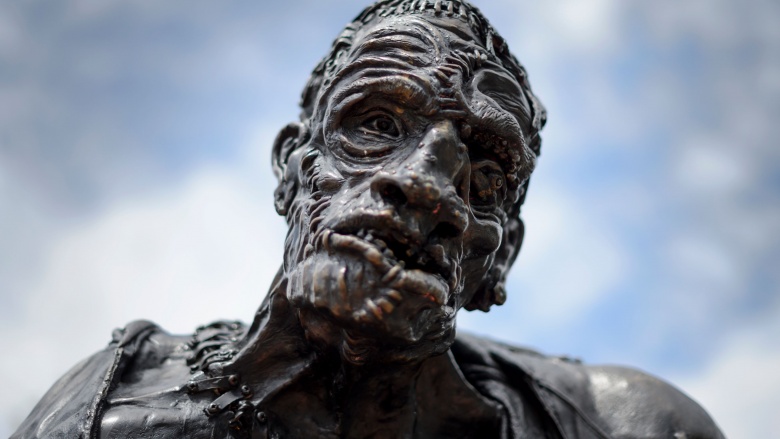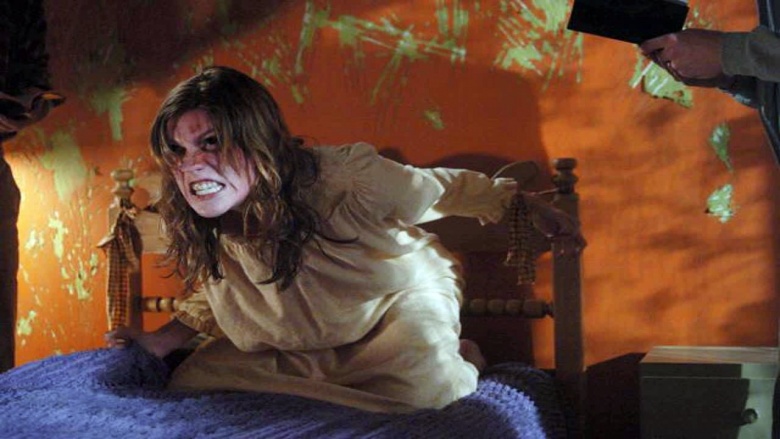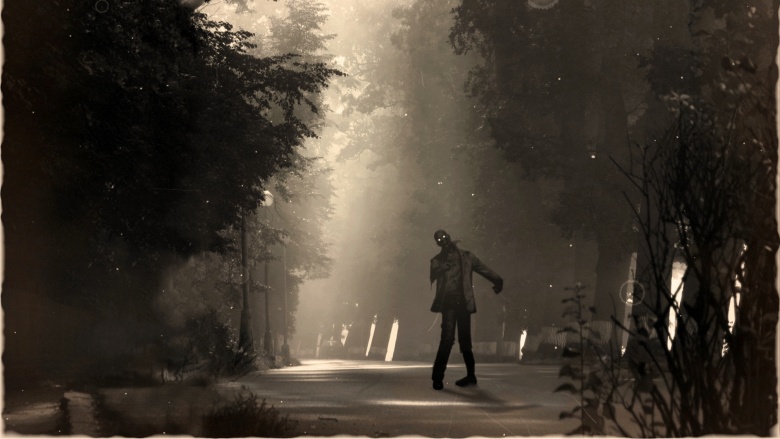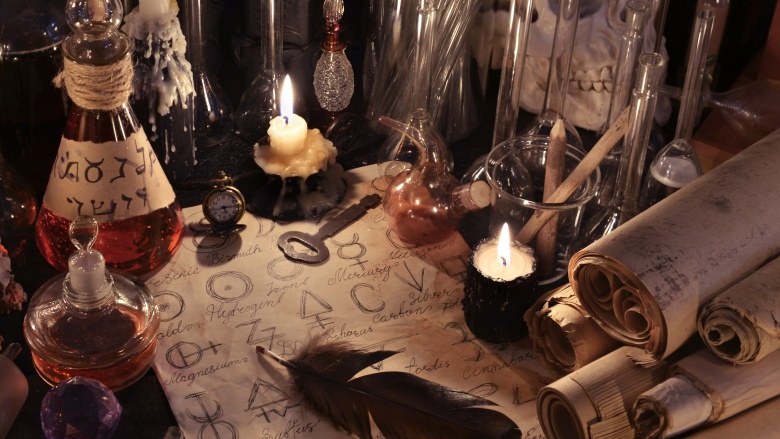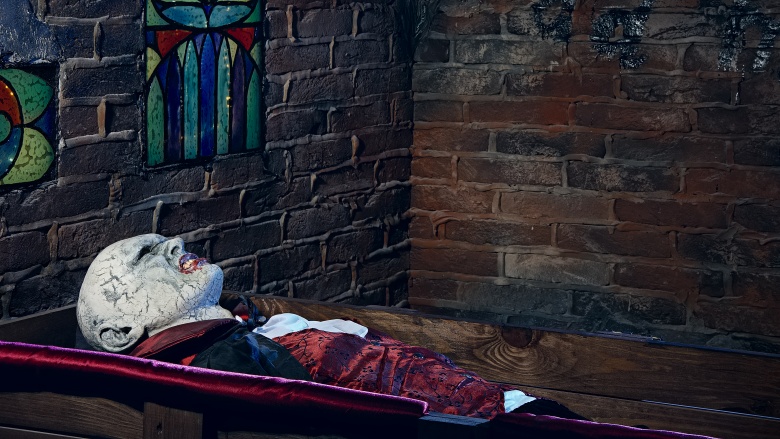Actual People Accused Of Being Real Halloween Monsters
Devils and werewolves, witches and warlocks, and Frankenstein's monster are the stuff of Halloween fun, but that wasn't always the case. For each of these monsters, there have been many instances when real, people were accused of being some of the most horrible monsters humans have ever dreamed up. In most cases, they were everyday people, living their everyday lives, until the unthinkable happened ... the fingers pointed.
The Waldensians
In France, witchcraft is often referred to as "vauderie." It's a direct reference to the Waldensians, a 12th-century Catholic sect declared heretical by the mainstream church. Their beef wasn't with the traditional beliefs of the Catholic faith, but rather the life of luxury and wealth enjoyed by the upper-class clergy. That seemed directly opposed to a lot of what they were teaching, and the Waldensians were having none of it.
Speaking out against the Catholic Church wasn't a good idea, and so the entire group were branded as witches. This was no case of ignoring them in hopes they'd go away, either: It was war. A book called "Incentives Against the Sect of Waldensians" detailed how to identify, hunt, torture and execute the members of the sect. There're only four copies left today (so good luck reserving it at your local library), and it gets into some pretty dark stuff. The crusade waged against the Waldensians was one of the first of the large-scale witch hunts, carried out by people who claimed the sect was in league with the Devil to bring down the church. They were accused of everything from dancing beneath the night sky with demons, to nighttime orgies and worshipping the devil.
The sect remained active for a surprisingly long time, and by the time the Inquisition was gearing up for their witch hunts, Waldensians who had been captured and tortured into confessing all sorts of dark deeds had lent a considerable amount of credence to the idea they were in league with Satan. That put them squarely in the sights of the Inquisition, and that's one of the last places anyone would want to be.
Peter Stumpp
Peter Stumpp (alternately spelled Stumpf, Stubbe, or Stuppe) was a mid-16th century German farmer who was executed on Halloween in 1589. Unfortunately, we only have one surviving account of what happened in the town of Bedburg that autumn, but it's a detailed one. Rumors were circulating about a massive wolf-like creature, seen prowling the countryside at night, with "eyes great and large, which in the night sparkled like unto brands of fire." It was blamed for the deaths of livestock — and, reportedly, people — so villagers started arming themselves and heading out at night to try to catch the creature.
They eventually did. Sort of. According to the story, they surrounded the creature one night in 1589, several years after the stories had started. When they advanced, they found only Stumpp, and threatened him with torture unless he talked. He quickly confessed that he was the one terrorizing the countryside, killing at least 15 people along the way. It had all started when he made a pact with the Devil at 12 years old. In exchange for his soul, Satan gave him a belt that allowed him to turn into the massive, bloodthirsty wolf-man (a belt that was never found).
In addition to the murders of livestock and of people, Stumpp was accused of taking a demon mistress, eating his own son (whose mother was his own daughter, just to make things even weirder), and using his daytime activities to choose his next victim. For his crimes, he was executed by breaking on the wheel, then beheaded, and then burned (just in case). Tragically, his daughter and (very human) mistress were named as accomplices, and were also executed.
Just what was going on with Stumpp has been hotly debated, but there might be some truth to the rumors. While it's possible he was in the wrong place at the wrong time, it's also possible he was an actual serial killer. It's also possible that he was suffering from some sort of mental illness, and his life in a very unstable area plagued by real wolves led to his belief that he was one.
Alice Kyteler
Kyleter's Inn is a popular pub in Kilkenny, Ireland. Almost eight centuries after it was founded, it's still a place for locals and tourists alike. It was also founded by a woman run out of town for being a witch.
Alice Kyteler was born in the 13th century (actual dates vary), and grew up to have a string of husbands and children. When her one of her richer husbands became suddenly, inexplicably ill, he changed his will to leave his substantial assets entirely to Alice and her children, cutting out even his own children. It was the final straw, and the jealous stepchildren got together to accuse Alice of being a witch. Makes you appreciate today's lawsuit-happy culture a bit more, no?
The charges brought against her were gruesome, including sacrificing animals and leaving their pieces at the crossroads to summon Satan, and making potions from the remains of the dead, then giving them to anyone who wanted help with their love life or general life problems. Clearly, with that kind of power, there was no way she didn't use it for herself. Alice was accused of killing the husbands that she had bewitched into falling in love with her in the first place, all because she had designs on their wealth.
The accusations escalated and, by 1324, the church proclaimed the entire area to be under the influence of witchcraft. For the first time, practicing witchcraft was officially heresy, and what followed was a fight between Alice's secular allies and the church authorities. As per usual, the church won. Luckily (we think, unless she actually did kill people), Alice had plenty of time to get out of Ireland before the church gave their verdict. She fled to England, but the church wasn't done with those she left behind. One of her servants, Petronilla de Midia, was burned at the stake for her association with the witch. Alice, meanwhile, was never heard from again.
Giovanni Aldini
Everyone knows the story of Dr. Frankenstein and his monster, but you probably didn't know that Mary Shelley's inspiration for the misunderstood hulk came from a very real scientist. Giovanni Aldini was the nephew of Luigi Galvani, the founder of galvanism and the guy who did that creepy experiment with electrifying frog legs that made science class the most terrifying class. His nephew took it a few steps further, and tried the experiments on an entire human body. That body was George Foster, a serious piece of work hanged on January 18, 1803. His crime? Killing his wife and child, then dumping them in Regents Canal.
For Aldini, the hanging was fortuitous, indeed. English law at the time forbid the practice of burying the bodies of those who had been hanged (apparently, they smell terrific). Foster had only been hanging for an hour when Aldini deemed him perfect for his experiments, so he was quickly cut down and taken to the scientist's table. According to the Newgate Calendar, Foster's body twitched from the moment electricity was applied. One of his eyes opened, and his legs were "set in motion." The official records also suggest that someone died of fright not long after seeing what had to be a ghastly sight, making Foster officially a murderer from beyond the grave.
Aldini had a legitimate reason for his experiments — he hoped that finding a way to apply electricity to a recently deceased person might help him develop a method to resuscitate drowning victims. He performed his experiments in England and on the continent, and while he undoubtedly gave countless people nightmares and sleepless nights, it was the College of Surgeons who finally managed to restart a heart. As usual, legit science trumps mad science.
Abhartach
Information on just how real this person was is sketchy, but that's not entirely surprising. Record-keeping from the 5th and 6th centuries leaves just a smidge to be desired. We do know that Ireland was once ruled by a scattering of chieftains, who staked claim to lands and held their territories against intrusion from neighboring chieftains. In an area that's now the northern Derry, one of the chieftains was called Abhartach. No one liked him, as he was reportedly incredibly evil, and rumored to have some sort of magical powers. The magic part might not be legit, but we can believe in someone so downright nasty, he managed to ally all his neighbors against him.
He was finally killed by a rival chieftain called Cathan, who buried him standing upright in his grave. The legends say he returned the next night, and that he demanded his subjects pay him an entirely new type of tribute: a bowl of blood. Locals appealed to the monks at Gortnamoyagh, who told them he was a particular sort of undead called the dearg-diulai, who drank blood and were impossible to kill. Instead, they needed to return him to a grave that he couldn't escape from. So they tracked him down, killed him with a wooden sword, and re-buried him upside down. After adding ash twigs and thorns to the grave, it was sealed with a massive stone that's still there today. Most call it the Giant's Grave, but the ancient name is Leacht Abhartach, or "Abhartach's Sepulture."
How real is the story? We're not sure — witnesses are hard to come by these days. But we do know that, even today, the land is supposedly still cursed. Attempts to clear it ended badly, and it's been at the center of all sorts of disagreements between the family that owns it. Is it a vampire's curse? We'd rather not find out, by the sounds of him.
Anneliese Michel
Born in Bavaria in 1952, Anneliese Michel is perhaps the last embodiment of Satan you'd expect. Michel was part of a devoutly religious family, who believed that she needed to pay penance for her mother's sins. Her older sister was illegitimate, and when the 8-year-old girl died, the message was a clear one for the religious family. A even clearer sign came when Anneliese was 17 and she was diagnosed with epilepsy. The seizures got worse and worse, and she began showing classic signs of demonic possession. She heard voices telling her that she was damned, she asked for exorcisms, and she got worse and worse. Religious imagery sent her into a panic, and conventional medicines and treatments were no help.
During her exorcism, various voices gurgled out of her, claiming to be anyone from Hitler, Nero of Rome, Judas, and Satan himself. Michel (or her demons, anyway) violently refused food and water, instead spending her hours screaming, beating herself bloody, and licking up her own urine. Finally, she died of starvation and pneumonia on July 1, 1976, weighing only 68 pounds. She was buried next to her sister, in an area of the cemetery reserved for suicides, though the courts didn't agree, eventually charging and convicting her parents and the priests of negligent homicide. Still, when the Telegraph interviewed her mother before the release of The Exorcism of Emily Rose, a movie based on this incident, Anna Michel said, "I don't regret it. There was no other way."
Clairvius Narcisse
Zombies are popular any time of the year, not just at Halloween. But they're all in good fun, not real, right?
Not so fast.
Clairvius Narcisse died in 1962, two days after checking himself into a hospital in Haiti. He'd been having trouble breathing, and after he died, his body was refrigerated for the 20 hours it took for his family to make arrangements to have him buried in their plot. Fast forward 18 years, to Angelina Narcisse who was in a local market when a man came up to her, introduced himself by a pet name she had called her brother, and said that he was, in fact, her brother.
This, of course, attracted considerable attention, and even the medical and psychiatric professionals that spoke with him agreed that he was, in fact, Clairvius Narcisse. And he had a hell of a story. According to him, his brother had arranged for Clairvius to be drugged, abducted, and sold into slave labor as an actual zombie, to get him out of the picture so brother dearest could get a bigger piece of their inheritance. Of course, how does one drug and zombify an actual human? Well, when a Harvard grad student investigated, he theorized that victims were given a potent mixture that contained things like nightshade, henbane, and various hallucinogens. The resulting state was one very, very much like death, and when they were exhumed and revived, the resulting brain damage made them behave much like the mindless, snuffling zombies we see on TV (without the hunger for brains. As far as we know).
Walpurga Hausman
There were plenty of people accused of witchcraft, but the accusations against Hausman were extra-impressive in their completeness. Accused of being both a witch and a vampire, the multi-tasking Walpurga Hausman was burned at the stake on September 10, 1587, in Dillingen, Germany. We still have her testimony, which was given both at "kindly questioning and also torture."
A widow and a midwife, Hausman had been tending the women and children of the village for years. That made her an undoubtedly valuable ally to the Devil, whom she met and signed a pact with not long after she was widowed. Even though she fought the good fight against his temptations, she was eventually baptised, and given a demonic familiar. It was that familiar (and lover) who gave her a special salve that would kill anyone (mostly newborns) who it touched. Once the children were dead, she would occasionally dig up their remains and use them in her evil rituals. In some cases, she confessed that she would drink the blood of the babies first, then spit it out when she next met the Devil, so he could make more of the salve.
Holy Water protected women and children from her, but she reportedly had a way around that, too. She would give Holy Water to her victims herself, which she had sabotaged by diluting it with some of her own, evil water to it. Not surprisingly, she was found absolutely guilty on all counts, and was sentenced to death by burning. But first, she was to be escorted through the city to five locations. At each stop, she was to be cut open with a hot iron, before finally being burned and her ashes scattered in the nearest river. Executions back then were less efficient than they were messages to any demons watching from Hell, mouths agape at what might happen to them if they dared trifle with the twisted creativity of humanity.
Jure Grando
Jure Grando lived in the mid-17th century Kringa, Croatia. According to witnesses of the time, Grando spent 16 years after his death returning to walk the night and to visit his widow. After all, even vampires need love. Now, if Grando had kept it in the family, his reign on Earth might have lasted a bit longer. However, there was apparently a bit of terrorizing going on, too, and it was said that Grando would spend some nights going from door to door in the village, knocking. Anyone who answered would die soon after.
It's not clear why the mayor waited 16 years to act (typical red-tape bureaucracy, probably), but he finally assembled a group of nine men to open Grando's grave. What they found was a classic vampire: a corpse with a rosy complexion and one that definitely hadn't decayed in any way. Their first attempt to kill him by staking him through the heart with a hawthorn branch failed, so they decided to cut off his head. The vampire started screaming, but the beheading worked, and Count Grando was no more. Even today the town remembers him with a Vampire Bar, and a plaque dedicated to those nine that put an end to the vampire's nightly exploits.
Supposedly. After all, you never know with the undead.




